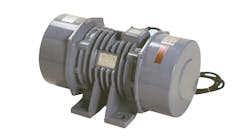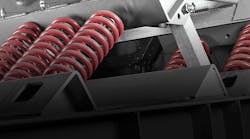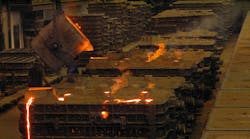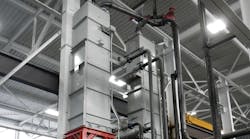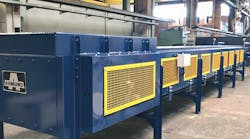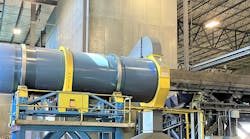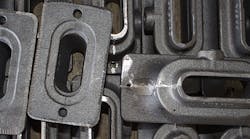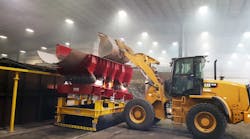If you have a vibratory conveyor system installed at your metalcasting operation you may be surprised to learn how much innovation is represented by that system — or how much innovation you may still accomplish with it. Functionally speaking, vibratory conveyors are effective for transporting materials safely and reliably: they carry hot and heavy objects without spillage or damage, and can be enclosed to ensure sand and metal dust are not released into the plant atmosphere. They're also adaptable to different types of operations, e.g., indexing out, indexing to a closed furnace, variable-speed charge, etc.
Belt conveyors or material handling vehicles may be used to charge furnaces or carry heavy loads, but cannot withstand the heat or shock of sustained activity.
What makes a vibratory conveyor innovative is not necessarily how it works but how it is designed and assembled. Conveyor Dynamics Corp. has been perfecting vibratory systems for more than two decades, including developments based on the user experience of metalcasting customers.
CDC's Dyna Sync Dynamic Drive System™ is a dynamically balanced, synchronous drive system uses patented stabilizers and chrome manganese steel coil springs for optimal efficiency and longevity. The amplitude and speed (up to 1,200 RPM) are variable, and easily adjustable to match the travel speed and product flow of a particular metalcasting installation.
With the Dyna Sync system, zero-tolerance bearings, HTD belts, cogged sprockets, eccentric shafts, and the need for realignment all become unnecessary.
CDC also works with different spring manufacturers to optimize the selection of springs for each application. CDC springs are formed from larger diameter bars and incorporate with one less coil, achieving the same spring rate as more widely adopted designs. This reduces the stress concentration in the pigtail, and achieves longer stroke capabilities and better spacing between the coils, for easier access to the spring fasteners.
Also, CDC uses contoured cast spring retainers to match the spring profile, with serrated seats for better clamping. These details contribute to more reliable conveyor performance, including higher availability.
CDC also incorporates dynamically balanced and isolated designs that improve on standard crank-arm, single-mass conveyors by reducing the risk of vibration transmission — which can reduce system performance and incur wider damage to a plant.
Another CDC innovation is the engineered, ductile iron stabilizer developed to improve upon and replace aluminum rocker arms, to improve on performance strength and longevity.
Where a vibratory conveyor is installed and how it will be used by a metalcasting operation are critical to its design, and performance. CDC engineers design equipment to interface with other machines, including simulations that anticipate the working operation prior to installation.
Some conveyor installations require a low-profile system, with the trough just a few inches above the floor. This calls for customized drive components, springs, and stabilizers, and all these are possible thanks to the custom-design capabilities at CDC.
All components are designed, engineered, manufactured, and machined by Conveyor Dynamics, which means that streamlines component and system development, and also makes customized production and spare or replacement parts production simple and convenient. Many of these parts can be installed as replacements to vibratory conveyors of other designs, too.
Vibratory conveyors are not ordinary machines, but for metalcasters they may be essential to the high-availability and safety now required for optimal production rates. With the maintenance or replacement cycles such machinery demands, metalcasters should look for the innovations in conveyor design and performance that CDC has already established.
Learn more by visiting www.conveyordynamics.com

